Hiking Shirt Essentials: A Guide to Choosing the Best for Your Adventures
Introduction
Ever found yourself on a trail, feeling all sweaty, sticky, or even sunburned because you didn’t wear the right shirt? Trust me, I’ve been there. Choosing the right hiking shirt can significantly enhance your outdoor experience.
Why the Right Hiking Shirt Matters
Embarking on a hiking adventure isn’t just about picking the right trail or having a map; it’s also about ensuring you’re properly equipped for the journey ahead. Among the essentials, a good hiking shirt plays a pivotal role in enhancing your outdoor experience. Here’s why selecting the appropriate hiking attire isn’t just a matter of preference but necessity.
Impact on Comfort
Imagine yourself navigating through rugged terrains, ascending steep hills, or traversing through dense forests. Now, imagine doing all of that in a shirt that’s ill-suited for the task – it’s damp, sticky, and just downright uncomfortable. This scenario underscores the importance of a well-chosen hiking shirt. Here are key factors that highlight its impact on comfort:
- Moisture Management: A high-quality hiking shirt is designed to wick sweat away from your body, keeping you dry and comfortable throughout your journey. Unlike cotton, which tends to retain moisture, materials like polyester or merino wool excel in moisture management.
- Breathability: An ideal hiking shirt allows air to circulate, helping to regulate your body temperature. This is crucial in preventing overheating in warm conditions and maintaining warmth when it’s cooler.
- Fit and Mobility: A shirt that fits well but also allows for a full range of motion is essential for hiking. You need to be able to move freely without restriction, whether you’re climbing over a fallen tree or reaching up to navigate a tricky path.
Protecting Against the Elements
The great outdoors is unpredictable, and being prepared means having gear that protects you from whatever you might face. Here’s how the right hiking shirt serves as your frontline defense against the elements:
- Sun Protection: Many hiking shirts come with built-in UV protection, which is vital for preventing sunburn and long-term skin damage, especially at high altitudes where the sun’s rays are more intense.
- Wind and Weather Resistance: While not all hiking shirts are windproof, having a layer that can shield you from brisk winds makes a significant difference in your comfort. Additionally, some shirts offer a degree of water resistance for light rain, though they’re not a substitute for a rain jacket.
- Insect and Abrasion Protection: In bug-infested areas, a shirt that’s treated with insect repellent or has a tight weave can help keep pests at bay. Similarly, a durable fabric is essential for protecting your skin from scratches and abrasions caused by brush or rocks.
Features to Look for in a Hiking Shirt
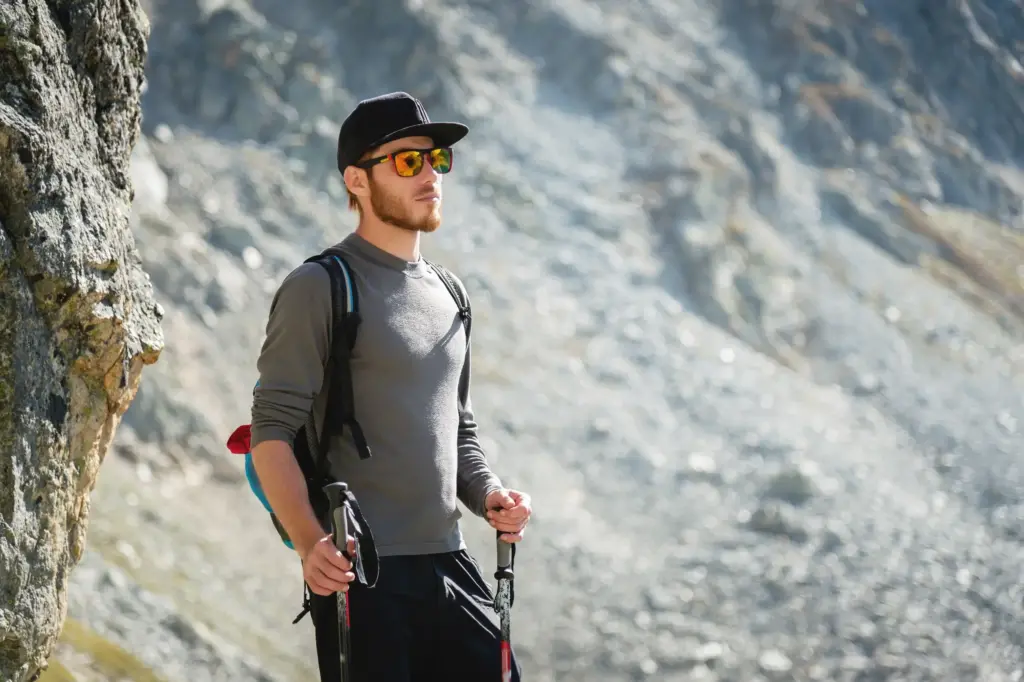
Material and Breathability
The fabric of your hiking shirt is its most fundamental feature. Different materials cater to varied environments and personal preferences.
- Synthetic Materials: These typically include polyester, nylon, and spandex. Polyester is loved for its quick-drying nature and resistance to abrasion. Nylon is lighter and known for its exceptional strength and stretch. Spandex, usually blended with other fabrics, offers elasticity and form fit.
- Natural Materials: Merino wool is a standout. Unlike regular wool, Merino is soft against the skin and boasts impressive temperature regulation, making it suitable for both summer and winter hikes. Additionally, it has natural anti-bacterial properties, helping to combat odor.
- Breathability: It’s crucial, especially for rigorous hikes. Breathability ensures that air can flow freely through the fabric, helping to cool you down. Look for shirts with ventilation features like mesh panels or vented back yokes for increased air circulation.
UPF Protection
The Ultraviolet Protection Factor (UPF) is a measure of how effectively a fabric shields the skin from harmful UV rays.
- Understanding UPF Ratings: A shirt with UPF 30 means that only 1/30th of the sun’s UV radiation can reach the skin. The higher the UPF rating, the greater the protection. Aim for shirts rated UPF 50+ for maximum protection.
- How UPF Differs from SPF: While UPF measures the protection a fabric offers from UV rays, SPF (Sun Protection Factor) is used for sunscreens and indicates how long it will protect your skin from burning. UPF offers a consistent shield without reapplication, unlike sunscreens.
Moisture-Wicking Properties
For those intense hikes where you’re bound to break a sweat, moisture-wicking properties are a lifesaver.
- How It Works: Moisture-wicking fabrics draw sweat away from the body to the exterior of the shirt, where it can evaporate more quickly. This ensures that you remain dry and comfortable throughout your hike.
- Benefits: Beyond comfort, moisture-wicking prevents potential issues like chafing or blisters. It also helps regulate body temperature by reducing the chilling effect of sweat against the skin in windy conditions.
Durability and Stitching
When you’re up against the wild, you need a shirt that can keep pace.
- Thread Count and Weave: A higher thread count generally means a denser, more durable fabric. The type of weave (like twill or ripstop) can also influence durability. Ripstop fabrics, for example, have a special reinforcing technique making them resistant to tearing.
- Stitch Type: Flatlock and double-stitched seams are indicators of quality. They reduce friction against the skin and are more resilient against wear and tear.
- Reinforced Areas: For added durability, some hiking shirts feature reinforced areas prone to wear, like elbows or shoulders.
- Abrasion Resistance: This determines how the material stands up against rough surfaces. If you’re hiking in areas with lots of brush or require some scrambling, it’s an important factor.
Product Reviews: Hiking Shirts for Outdoor Enthusiasts

When preparing for outdoor activities, choosing the right hiking shirt is crucial for comfort, protection, and overall enjoyment. Below, we review six popular hiking shirts, highlighting their pros and cons to help you make an informed decision.
Men’s Outdoor Hiking Shirts
1. NORTHYARD Men’s Athletic Running Shirts
Pros:
- UPF 50+ provides excellent UV protection, keeping your skin safe from harmful rays.
- Made from ultra-soft and quick-dry fabric, ensuring you stay dry and comfortable during activities.
- Features 4-way stretch technology for flexibility and comfort, with raglan sleeves for a full range of motion.
- Ergonomic design with flat lock seams and no tag collar to minimize friction.
Cons:
- Limited color options may not meet everyone’s preferences.
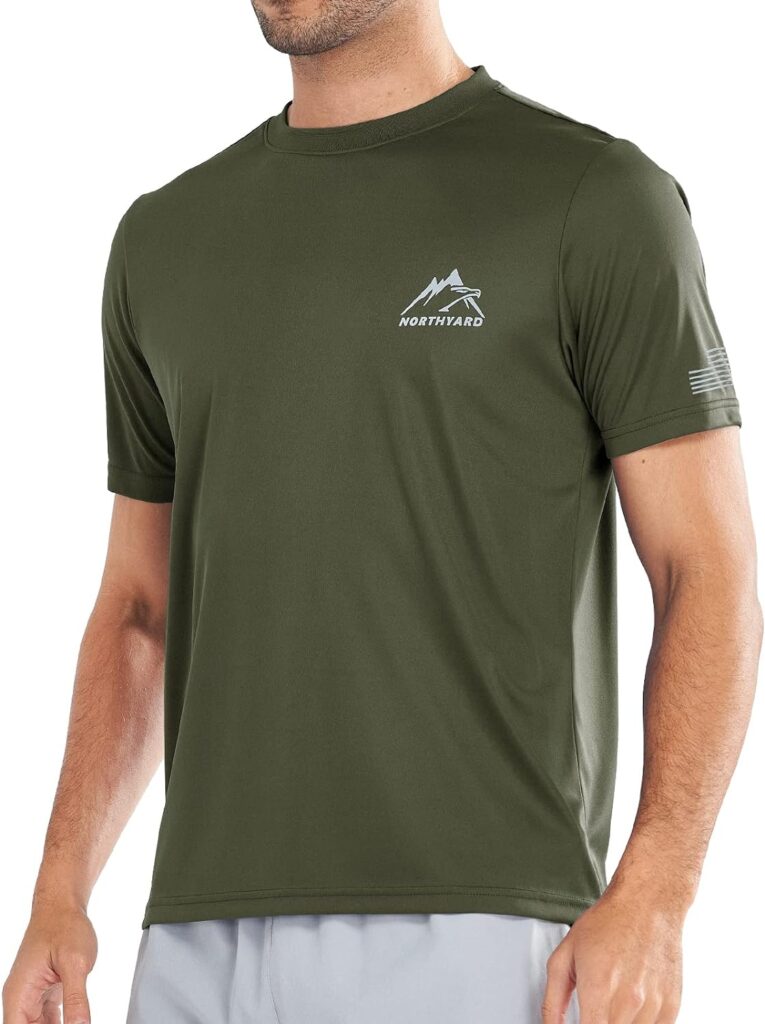
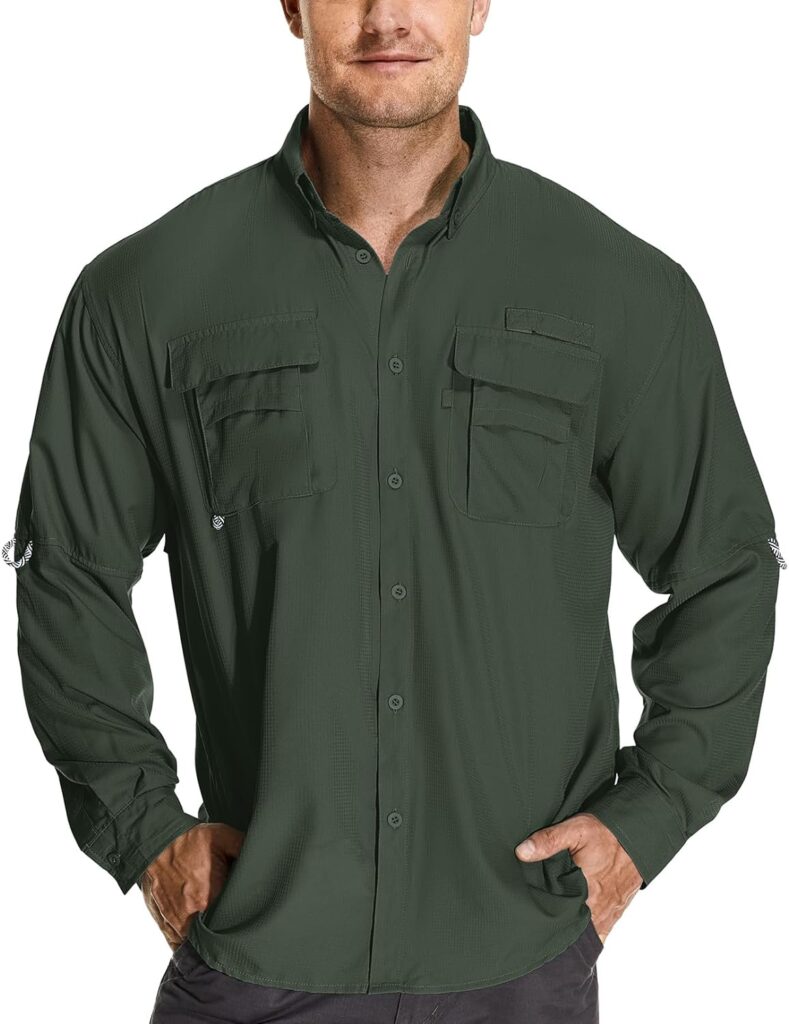
2. Mens Safari Shirts Long Sleeve UV Protection
Pros:
- Omni-Shade UPF 50 fabric offers maximum sun protection.
- Lightweight, quick-dry polyester fabric with moisture-wicking properties.
- Roll-up sleeves and mesh-lined vented back for breathability and adaptability to changing temperatures.
- Features two chest pockets with additional loops and slots for convenience.
Cons:
- The relaxed fit might not be suitable for those preferring a more form-fitting style.
3. 33,000ft Men’s Long Sleeve Sun Protection Shirt
Pros:
- UPF50+ rating for excellent sun protection.
- Breathable and quick-dry fabric with high-tech air vent for superior cooling.
- Water-resistant and wrinkle-free material, ideal for travel and outdoor activities.
- Functional design with chest utility pockets and a built-in glasses cleaning cloth.
Cons:
- Higher price point compared to some other options.

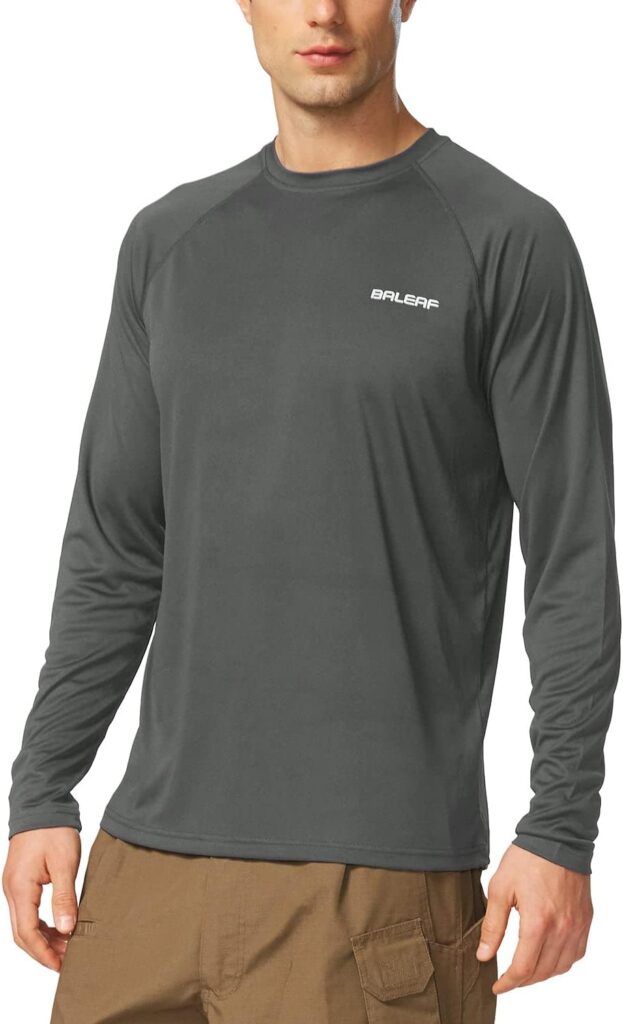
4. BALEAF Men’s Sun Protection Shirts
Pros:
- Lightweight and moisture-wicking fabric keeps you dry and comfortable.
- UPF 50+ fabric shields your skin from the sun’s harmful rays.
- Flatlock seamlines and tagless collar prevent chafing.
- Relaxed fit with raglan sleeves for a full range of motion.
Cons:
- Some users may find the fit too loose for high-intensity activities.
5. ATG by Wrangler Men’s Long Sleeve Mixed Material Shirt
Pros:
- Breathable utility blend fabric with moisture-wicking capabilities.
- UV protection with a UPF 30 rating.
- Convertible sleeve system and knit construction for flexibility and ease of movement.
- Features secure storage options including two flap pockets and a zip utility pocket.
Cons:
- Nylon/Polyester blend might not be as quick-drying as 100% polyester options.

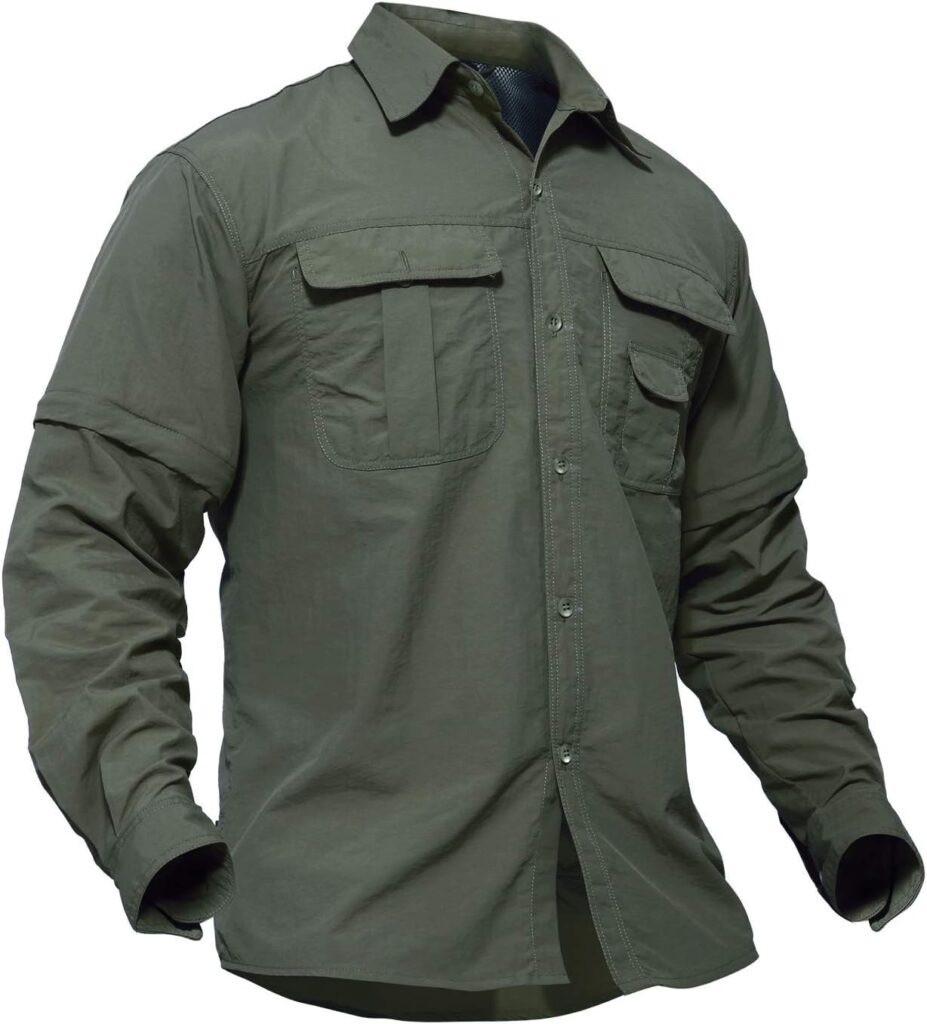
6. TACVASEN Men’s Breathable Quick Dry UV Protection Shirt
Pros:
- Made from nylon for quick drying, abrasion resistance, and UV protection.
- Convertible long sleeves with zippers can be adapted to short sleeves.
- Mesh back design for enhanced ventilation in warm climates.
- Multiple pockets for convenient storage.
Cons:
- The style and zipper sleeves may not appeal to all users, and sizing may run small.
Women’s Outdoor Hiking Shirts
1. BALEAF Women’s UPF 50+ Sun Shirts
Pros:
- UPF 50+ fabric offers excellent sun protection.
- Lightweight material wicks moisture away, keeping you cool and dry.
- Raglan sleeves and flatlock seams for reduced chafing and full range of motion.
- Soft against the skin, can be worn alone or as a base layer.
Cons:
- Basic design may not appeal to those looking for more outdoor-specific features.
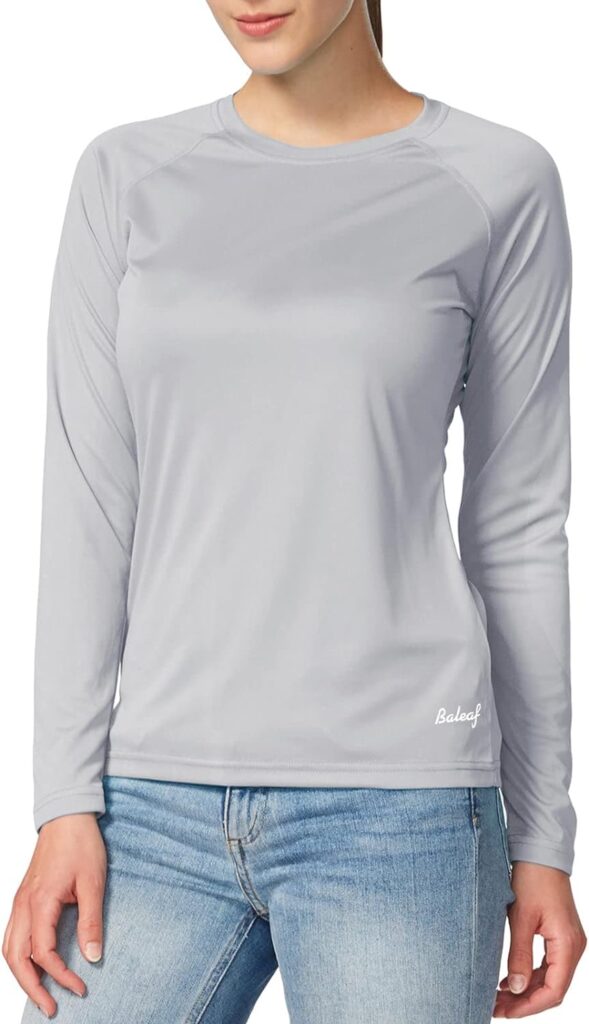
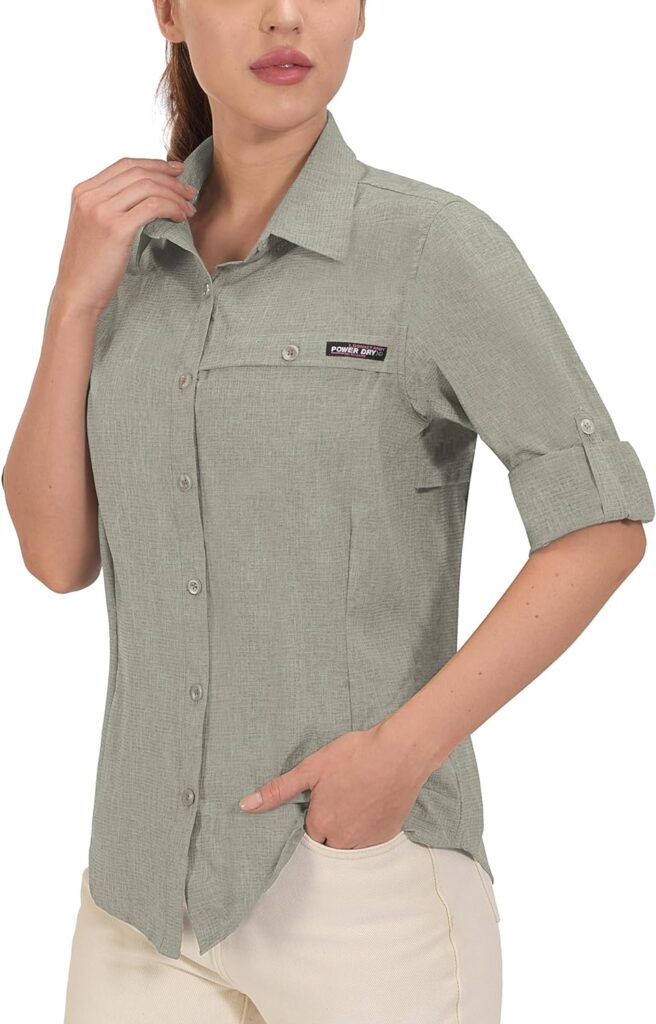
2. Little Donkey Andy Women’s UPF 50+ UV Protection Shirt
Pros:
- Air-holes tech fabric is ultra-breathable, perfect for hot and humid conditions.
- UPF 50+ provides maximum sun protection.
- Lightweight and quick-drying material with hidden mesh panels for additional cooling.
- Convertible sleeves for versatility in changing temperatures.
Cons:
- Higher price point compared to some other options.
3. G4Free Women’s UPF 50+ UV Shirts
Pros:
- UPF 50+ rating protects skin from harmful rays.
- High side slits and high-low rounded hem for a flattering look and coverage.
- Ultra-soft, lightweight, and breathable fabric for maximum comfort.
- Quick-drying material keeps you cool and dry throughout the day.
Cons:
- Loose fit may not be suitable for those preferring a tighter, more form-fitting style.
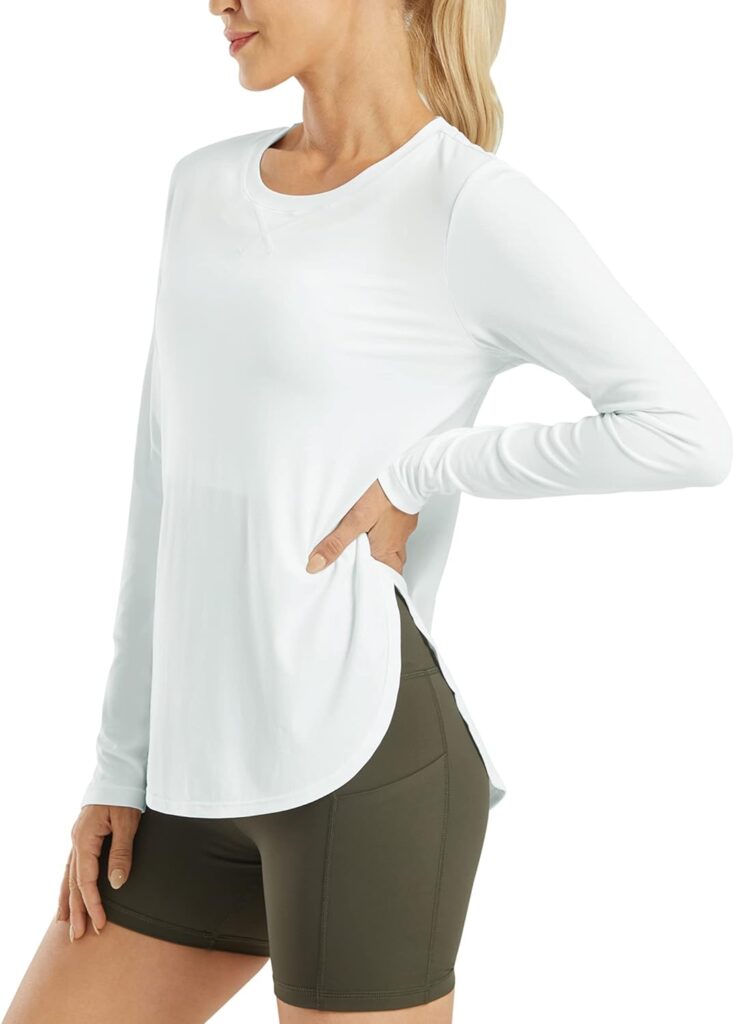
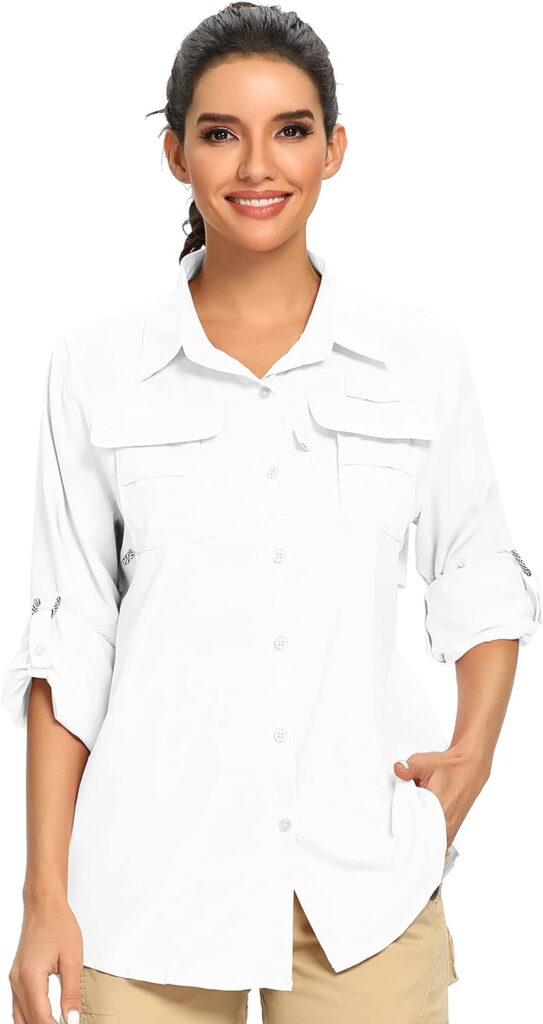
4. Women’s UPF 50+ UV Sun Protection Safari Shirt
Pros:
- Omni-Shade UPF 50 fabric offers great protection against the sun.
- Ultra-light and dry fit fabric with Omni-Wick technology for moisture management.
- Features two chest pockets and a sunglasses hanger loop for convenience.
- Mesh-lined vented back for breathability, with roll-up sleeves for warmer days.
Cons:
- Design may be too utilitarian for casual wear outside of outdoor activities.
5. TBMPOY Womens UPF 50+ Sun Protection Hoodie Shirt
Pros:
- Lightweight fabric with moisture-wicking properties for cool comfort.
- UPF 50+ protection for harmful UV rays, with a hood for added neck protection.
- Low profile thumbholes keep sleeves in place and trap warmth.
- Flatlock seamlines and no tag collar for increased comfort.
Cons:
- Color options may not appeal to all tastes.
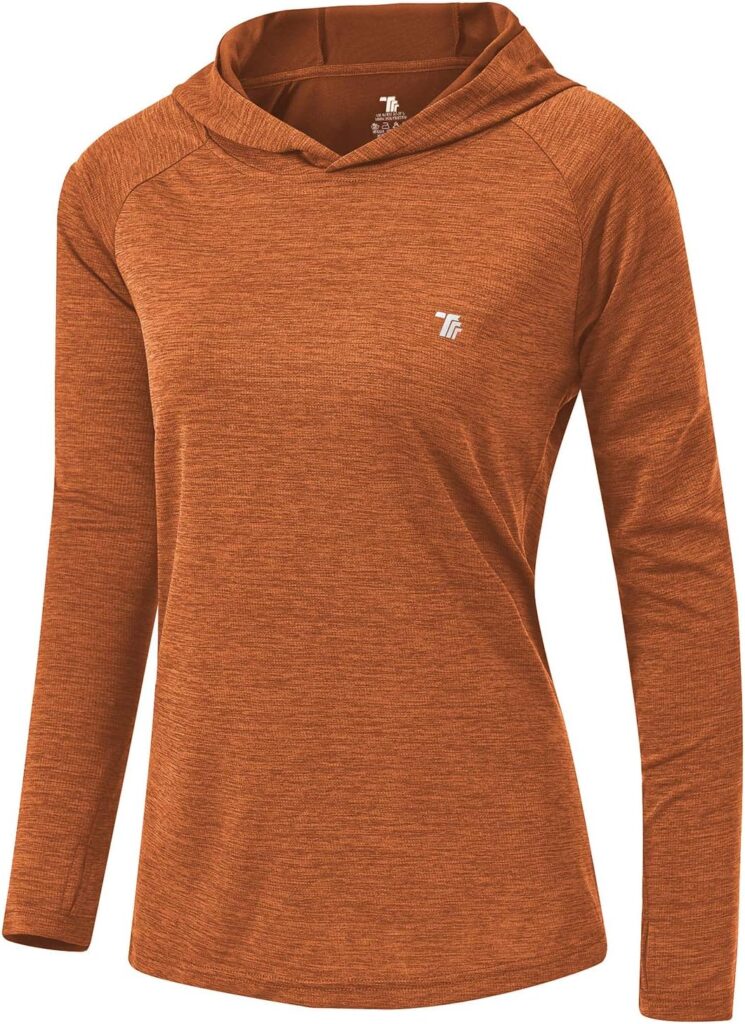
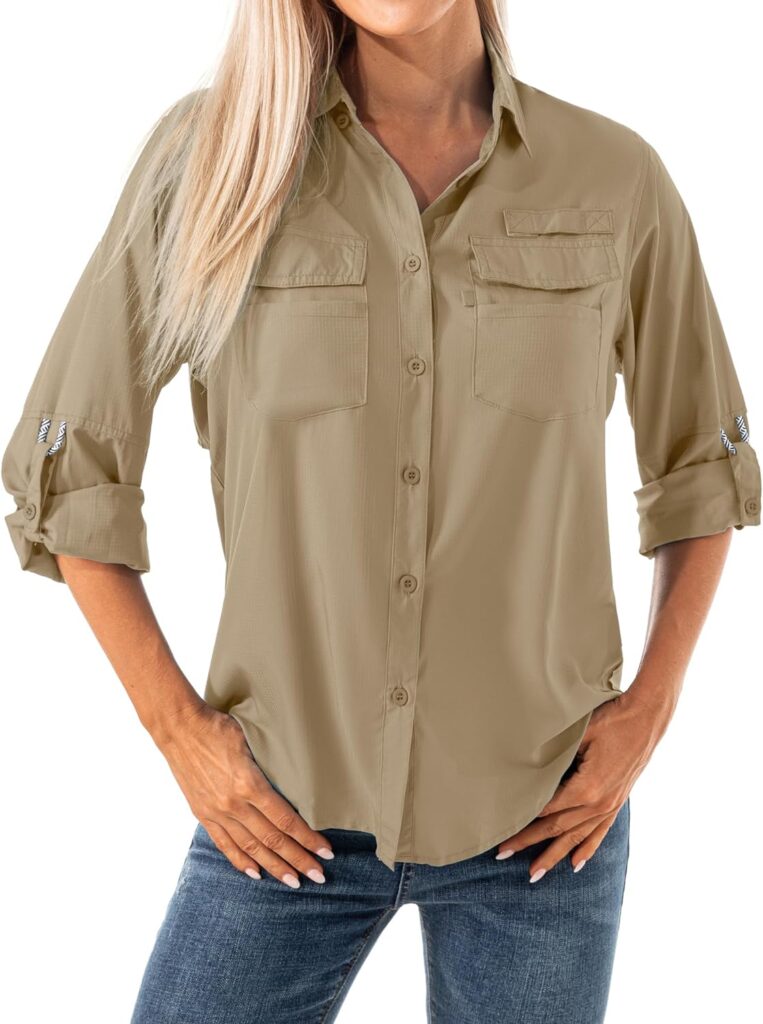
6. Women’s Quick Dry Sun UV Protection Convertible Long Sleeve Shirts
Pros:
- Omni-Shade UPF 50 fabric ensures maximum protection against the sun.
- Dry fit and comfortable fabric suitable for various outdoor activities.
- Two chest pockets and a sunglasses loop for practical storage.
- Convertible sleeves and mesh-lined back for adaptability and comfort in changing weather.
Cons:
- Similar in design and functionality to other shirts, making standout features less noticeable.
How to Care for Your Hiking Shirt

Maintaining your hiking shirt is crucial for prolonging its life and ensuring it continues to provide the protection and comfort you need on your adventures. Given the investment you make in high-quality hiking apparel, taking proper care of your gear is a smart way to protect that investment. Here are detailed tips on how to care for your hiking shirt, keeping it in prime condition for your next outdoor excursion.
Reading the Care Label: The Foundation of Garment Care
- Understand the Symbols: The care label on your hiking shirt is your roadmap to understanding how to treat the fabric. These labels contain symbols and instructions on washing, drying, and ironing. Adhering to these guidelines ensures the longevity of your shirt’s material, color, and technical features.
- Material-Specific Instructions: Whether your shirt is made from synthetic fibers like polyester or natural ones like merino wool, the care label will provide material-specific instructions. This is crucial because different materials require different care strategies.
Washing: Preserving Fabric Integrity
- Cold Water Cycle: Washing your hiking shirt in cold water helps maintain the integrity of the fabric and prevents shrinking. Cold water is also more environmentally friendly.
- Mild Detergent: Opt for a mild or specialized detergent that’s free from harsh chemicals. Harsh detergents can strip away the fabric’s protective coatings, such as water-repellent or insect-repellent finishes.
- Turn Inside Out: To protect the outer surface of your shirt, turn it inside out before washing. This helps minimize abrasion and wear on the exterior, keeping colors vibrant and finishes intact.
- Avoid Fabric Softeners: Fabric softeners can impair the wicking properties of technical fabrics, reducing their ability to manage moisture effectively.
Drying: The Right Technique Matters
- Air Dry When Possible: Air drying is the best way to dry your hiking shirt. It prevents the potential damage caused by high heat in dryers, such as shrinking or degradation of fabric integrity.
- Low Heat If Using a Dryer: If you need to use a dryer, select a low heat setting. Excessive heat can harm the fibers, affecting the shirt’s shape and technical features.
Storage: Keeping Your Shirt Ready for Adventure
- Cool, Dry Place: Store your hiking shirt in a cool, dry place away from direct sunlight. Moisture can lead to mildew, and heat can cause fabrics to degrade over time.
- Fold, Don’t Hang: Folding your shirt rather than hanging it can prevent stretching or deformation, especially for knit fabrics like merino wool.
Repairs: Addressing Wear and Tear
- Prompt Repairs: Tend to any small tears or loose threads as soon as possible. Neglecting minor damage can lead to bigger issues, compromising the shirt’s functionality.
- Professional Repairs: For complex repairs, especially on shirts made from technical fabrics or those with special treatments, consider seeking professional help. A specialist can ensure that the repair maintains the garment’s performance features.
General Considerations for Choosing a Hiking Shirt
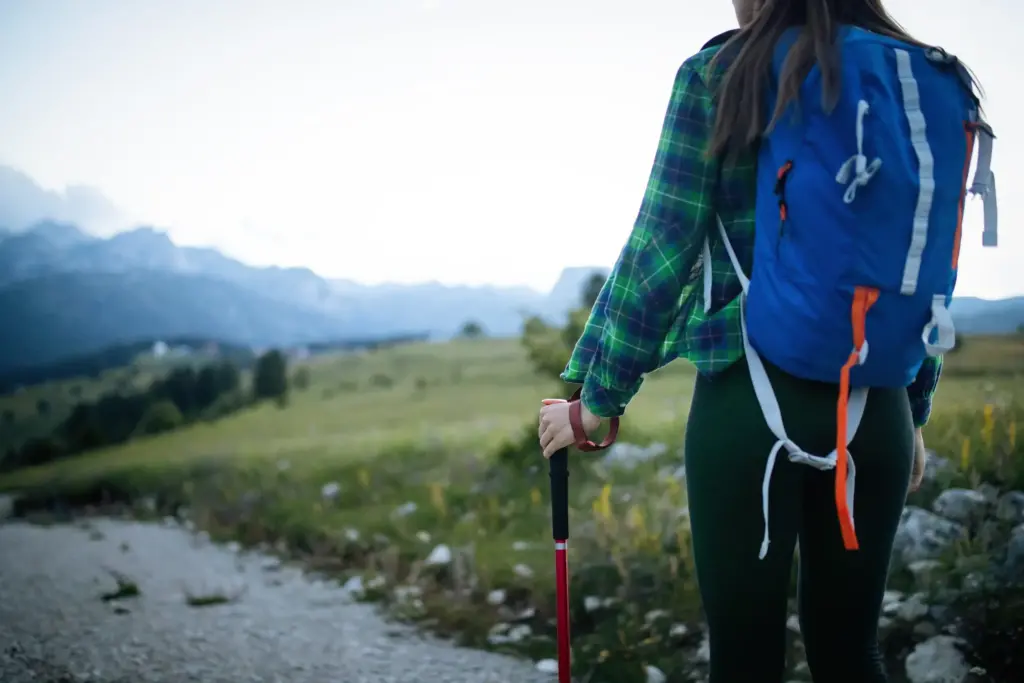
Selecting the right hiking shirt involves more than just picking your favorite color or the first shirt you find on sale. It’s about finding a balance between comfort, functionality, and durability. Here are several key considerations to keep in mind to ensure you make the best choice for your outdoor adventures.
Fit: The Foundation of Comfort
- Just Right: The fit of your hiking shirt is crucial for comfort and mobility. It should be snug enough to allow for efficient moisture wicking and warmth when needed, yet loose enough to facilitate easy movement and airflow.
- Avoid Chafing: A shirt that’s too tight can lead to uncomfortable chafing, especially under backpack straps or in areas where movement is constant. Look for flat or minimal seams to reduce this risk.
- Freedom of Movement: Ensure the shirt allows for full range of motion. Features like gusseted underarms or stretch fabrics can enhance mobility, particularly important when climbing, reaching, or navigating challenging terrain.
Layering: Building Your Outdoor Wardrobe
- Layer Compatibility: Your hiking shirt should seamlessly integrate with your overall layering system. Consider whether you’ll be wearing it directly against your skin, over a base layer, or under a jacket to ensure it serves its intended purpose without bulk or restriction.
- Versatility: A versatile shirt can serve multiple functions, acting as a standalone piece in warm weather or as part of a layered ensemble in cooler conditions. This adaptability is key to managing changing weather and activity levels.
Color: More Than Just Aesthetic
- Temperature Management: Light-colored shirts are preferable in hot, sunny conditions as they reflect sunlight and help keep you cool. Conversely, in cooler weather or when UV exposure is less of a concern, darker colors can provide warmth and conceal dirt more effectively.
- Visibility: Bright colors can enhance visibility, useful for safety in areas where you need to be seen by fellow hikers or in emergency situations. However, if you’re hiking in areas where discretion is preferred, such as wildlife habitats, more muted tones may be beneficial.
Cost vs. Quality: Making a Smart Investment
- Long-Term Savings: While the initial cost of a high-quality hiking shirt may be higher, the investment pays off in the long run. Quality shirts are designed to withstand the rigors of outdoor use, meaning you’ll spend less over time replacing worn-out gear.
- Material and Construction: High-quality materials and thoughtful construction not only enhance comfort and performance but also contribute to the garment’s durability. Look for features like reinforced stitching, UV protection, and moisture-wicking fabrics.
- Performance Features: Investing in a shirt with specialized features like odor resistance, quick-dry technology, or insect repellent can significantly enhance your hiking experience, making the cost worthwhile.
Conclusion
The next time you hit the trail, ensure you’re dressed for the occasion. The right hiking shirt doesn’t just protect you; it enhances your outdoor experience. Ready for your next adventure? Gear up with the best hiking shirt!
FAQs
- Can I just wear a regular cotton shirt for hiking?
Cotton retains moisture and can make you feel damp and chilly. It’s best to opt for moisture-wicking fabrics. - How often should I replace my hiking shirts?
With regular wear and proper care, a good quality hiking shirt can last several seasons. - Do I need different shirts for different seasons?
Ideally, yes. Lightweight for summer and insulating materials, like merino wool, for colder hikes. - Does color matter when choosing a hiking shirt?
Light colors reflect sunlight and can keep you cooler in the sun. They also make you more visible in the wild. - Are branded hiking shirts better?
Not necessarily. It’s the features and fit that count. But known brands often offer reliable quality and warranties.
Resources
https://www.rei.com/learn/expert-advice/how-to-choose-hiking-clothes.html
https://alpkit.com/blogs/spotlight/how-to-clean-and-take-care-of-outdoor-clothing




